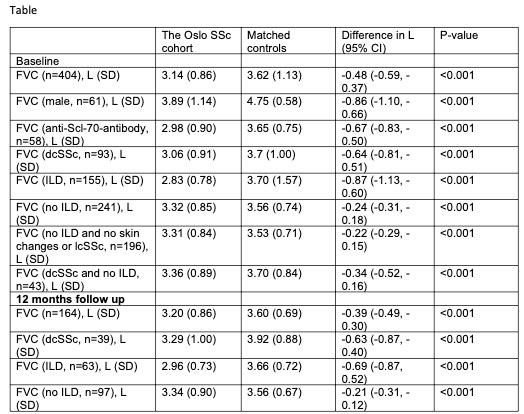Session Information
Date: Monday, November 14, 2022
Title: Systemic Sclerosis and Related Disorders – Clinical Poster III
Session Type: Poster Session D
Session Time: 1:00PM-3:00PM
Background/Purpose: Spirometry, in particular forced vital capacity (FVC), is a widely implemented tool in the initial diagnostic workup and monitoring of systemic sclerosis-related interstitial lung disease (SSc-ILD). In addition to ILD, several other extra-pulmonary complications can affect pulmonary function. There is currently limited data on lung function in SSc patients with and without ILD compared to a healthy reference population.
We aimed to compare forced vital capacity (FVC) of a well-defined SSc patient cohort with and without ILD to multi-ethnic reference values provided by the European Respiratory Society (ERS) global lung function initiative (1).
Methods: SSc patients from the Oslo University hospital SSc cohort with at least one PFT were included. We registered each patient’s first available FVC value and a follow-up FVC at 12 +/- 3 months if available. We registered clinical characteristics including sex, age, height, the extent of skin changes, and presence of ILD assessed on HRCT. Predicted FVC values from the reference population were calculated using the GLI 2012 equation (1), including age, height and ethnicity. Descriptive statistics were applied.
Results: In total, 404 SSc patients were included; of these 58 (14%) patients were anti-Scl 70-antibody positive, 61 (15%) were male, 155 (38%) had ILD and 93 (23%) had diffuse cutaneous SSc (dcSSc). At baseline, mean age was 55.8 (SD 14.0) years, and mean time from first non-Raynaud symptom was 35 (53.2) months. A follow-up spirometry at 12 +/-3 months was available in 164 (41%) patients. Mean FVC was 0.48 L lower at baseline compared to the reference population. At 12 +/-3 months the SSc cohorts mean FVC was 0.39 L lower compared to the reference group (Table). The low FVC values at baseline were most pronounced in patients with ILD (0.87L), in male patients (0.86L) and in anti— Scl 70 positive patients (0.67L). But SSc patients with no ILD showed also impaired FVC compared to the reference population (0.24L), even more pronounced when they had dcSSc (0.34L) (Table).
Conclusion: Mean FVC at baseline was significantly lower in SSc patients compared to the reference population. As expected, SSc patients with ILD had impaired FVC, but also patients without ILD and in patients with limited skin changes. This highlights the importance of other factors than ILD on lung function in SSc patients.
To cite this abstract in AMA style:
Fretheim H, Barua I, Midtvedt Ø, Garen T, Diep P, Durheim M, Brunborg C, Hoffmann-vold A. Patients with Systemic Sclerosis Have Impaired Forced Vital Capacity, Even in the Absence of Interstitial Lung Disease [abstract]. Arthritis Rheumatol. 2022; 74 (suppl 9). https://acrabstracts.org/abstract/patients-with-systemic-sclerosis-have-impaired-forced-vital-capacity-even-in-the-absence-of-interstitial-lung-disease/. Accessed .« Back to ACR Convergence 2022
ACR Meeting Abstracts - https://acrabstracts.org/abstract/patients-with-systemic-sclerosis-have-impaired-forced-vital-capacity-even-in-the-absence-of-interstitial-lung-disease/

